More than any other genres, fantasy and the oft-paired science fiction offer readers the opportunity to exercise their imaginations. The recently published novels in this week’s column do this superbly, taking readers to make-believe worlds to share fantastical adventures with intriguing characters in the past, present, or future.
Ages 4–8
Elsie Piddock Skips in Her Sleep (Candlewick Treasures). Eleanor Farjeon. Ill. Charlotte Voake. 2017. Candlewick.
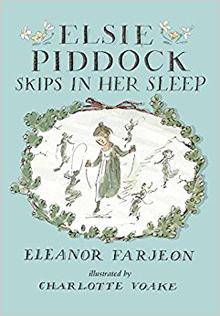 Elsie Piddock is a born skipper. As a five year old she can outskip everyone in her village, and at seven, she’s invited to join the fairies on the top of Mount Caburn for Master Skipper Andy-Spandy’s lessons on new skipping rope skills under the full moon. A year later, he adds magic to Elsie’s skipping rope, which will allow her to do all the fairy skips until she is too big for the rope. Many years later, when a greedy lord plans to build factories on Mount Caburn, Elsie, at the age of 109 and shrunk to the size of a seven year old, takes up her magic skipping rope once again to save Caburn for children and fairies forever. Voake’s delicate, softly colored watercolor-and-ink illustrations are the perfect match for this new edition of Farjeon’s classic tale, originally published in 1937.
Elsie Piddock is a born skipper. As a five year old she can outskip everyone in her village, and at seven, she’s invited to join the fairies on the top of Mount Caburn for Master Skipper Andy-Spandy’s lessons on new skipping rope skills under the full moon. A year later, he adds magic to Elsie’s skipping rope, which will allow her to do all the fairy skips until she is too big for the rope. Many years later, when a greedy lord plans to build factories on Mount Caburn, Elsie, at the age of 109 and shrunk to the size of a seven year old, takes up her magic skipping rope once again to save Caburn for children and fairies forever. Voake’s delicate, softly colored watercolor-and-ink illustrations are the perfect match for this new edition of Farjeon’s classic tale, originally published in 1937.
—CA
Ivy. Katherine Coville. Ill. Celia Kaspar. 2017. Alfred A. Knopf/Random House.
 Ivy lives in the tidy town of Broomsweep in a decidedly untidy cottage with her grandmother, where they care for sick animals, whether domestic, wild, or magical. When newly crowned Queen Emmeline announces a contest for best town in the kingdom, the townspeople (led by the mayor’s wife, Mistress Peevish) are certain that Broomsweep will win—but only if Grandmother and Ivy tidy up their cottage and get rid of all the animals, especially injured Cedric, a griffin, and Balthazar, a dragon with a bad cold. When trolls invade Broomsweep on the day Queen Emmeline arrives, however, the presence of the magical animals averts disaster and the queen declares Broomsweep the “most perfect, most unique, most fun of any town in the kingdom of Evermore.”
Ivy lives in the tidy town of Broomsweep in a decidedly untidy cottage with her grandmother, where they care for sick animals, whether domestic, wild, or magical. When newly crowned Queen Emmeline announces a contest for best town in the kingdom, the townspeople (led by the mayor’s wife, Mistress Peevish) are certain that Broomsweep will win—but only if Grandmother and Ivy tidy up their cottage and get rid of all the animals, especially injured Cedric, a griffin, and Balthazar, a dragon with a bad cold. When trolls invade Broomsweep on the day Queen Emmeline arrives, however, the presence of the magical animals averts disaster and the queen declares Broomsweep the “most perfect, most unique, most fun of any town in the kingdom of Evermore.”
—CA
Little Fox in the Forest. Stephanie Graegin. 2017. Schwartz & Wade/Random House.
 Blue-toned panels in this wordless book show a young girl selecting her stuffed fox as her old and treasured item to take to school for show-and-tell. While she is playing on the swings at recess, a bright orange young fox sneaks up and runs off with the beloved stuffed toy. In a pursuit through the forest, she and a friend make inquiries of various animals (shown as colorful images in the blue scenes) and eventually come upon a fairy-tale village of personified animals (shown in a doublespread completely done in bright colors). Upon reaching the home of Little Fox, she is reunited with her stuffed fox—but not for long as the ending panels reveal a surprise exchange. Young children will enjoy discovering more details with each rereading.
Blue-toned panels in this wordless book show a young girl selecting her stuffed fox as her old and treasured item to take to school for show-and-tell. While she is playing on the swings at recess, a bright orange young fox sneaks up and runs off with the beloved stuffed toy. In a pursuit through the forest, she and a friend make inquiries of various animals (shown as colorful images in the blue scenes) and eventually come upon a fairy-tale village of personified animals (shown in a doublespread completely done in bright colors). Upon reaching the home of Little Fox, she is reunited with her stuffed fox—but not for long as the ending panels reveal a surprise exchange. Young children will enjoy discovering more details with each rereading.
—CA
Prince Ribbit. Jonathan Emmett. Ill. Poly Bernatene. 2017. Peachtree.
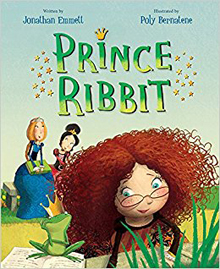 Princess Martha wants to know how things work, and her sisters believe anything they read, especially if it comes from a fairy tale. When Princesses Lucinda and Arabella find a talking frog, they believe that he will transform into human Prince Ribbit (and they treat the little green trickster like royalty and even give him “True Love’s Kiss!” to no avail). Suspicious Princess Martha explores scientific facts about different types of frogs and reads many stories about frogs before she can make up her mind. An unexpected twist surprises Princess Martha—and will surprise readers, too. Detailed digital art enhances the humor of this clever retelling of “The Frog Prince” with its timely message: “Just because it’s in a book doesn’t mean it’s true!”
Princess Martha wants to know how things work, and her sisters believe anything they read, especially if it comes from a fairy tale. When Princesses Lucinda and Arabella find a talking frog, they believe that he will transform into human Prince Ribbit (and they treat the little green trickster like royalty and even give him “True Love’s Kiss!” to no avail). Suspicious Princess Martha explores scientific facts about different types of frogs and reads many stories about frogs before she can make up her mind. An unexpected twist surprises Princess Martha—and will surprise readers, too. Detailed digital art enhances the humor of this clever retelling of “The Frog Prince” with its timely message: “Just because it’s in a book doesn’t mean it’s true!”
—NB
Princessland. Emily Jenkins. Ill. Yoko Tanaka. 2017. Farrar Straus Giroux.
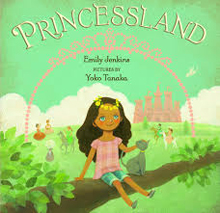 Romy is bored and so sad she doesn’t even want to be Romy. What would make her happy? Being in Princessland, where all girls are princesses. Her cat, Lady Cat, says she could probably take Romy there. Each stop along the walk that Lady Cat takes her on reminds Romy of another princess-pleasing aspect of Princessland. For example, when the baker gives her a day-old muffin (and Lady Cat, a dish of milk), Romy lists all the good things that princesses feast on in Princessland. Once back home at dinner time, Romy asks, “Weren’t you going to take me to Princessland?” Lady Cat responds, “Ah, but I am sure I did.” Tanaka’s softly colored paintings beautifully portray Romy’s imaginative journey.
Romy is bored and so sad she doesn’t even want to be Romy. What would make her happy? Being in Princessland, where all girls are princesses. Her cat, Lady Cat, says she could probably take Romy there. Each stop along the walk that Lady Cat takes her on reminds Romy of another princess-pleasing aspect of Princessland. For example, when the baker gives her a day-old muffin (and Lady Cat, a dish of milk), Romy lists all the good things that princesses feast on in Princessland. Once back home at dinner time, Romy asks, “Weren’t you going to take me to Princessland?” Lady Cat responds, “Ah, but I am sure I did.” Tanaka’s softly colored paintings beautifully portray Romy’s imaginative journey.
—CA
Ages 9–11
The House of Months and Years. Emma Trevayne. 2017. Simon & Schuster.
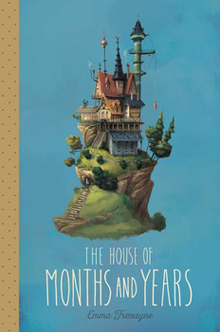 Ten-year-old Amelia is unhappy about her family’s decision to move into her cousins’ house after they lose their parents in a car accident. As she explores the old house, Amelia feels she’s being watched. Then a shifting ghostlike/human presence reveals itself as Horatio, the builder of the house. He has chosen Amelia as the person to whom he’ll reveal the house’s special secrets. It is a calendar house with a floor for each season, twelve rooms, fifty-two windows, other calendar-related features, and a door to nowhere, through which he can take her time-traveling. Amelia enjoys the attention she’s getting from Horatio and their adventurous trips that offer a taste of what might be possible—the building of her own calendar house, living forever, and endless traveling through time. But all is not what it seems to be, something which readers will identify before Amelia does in this satisfyingly scary fantasy.
Ten-year-old Amelia is unhappy about her family’s decision to move into her cousins’ house after they lose their parents in a car accident. As she explores the old house, Amelia feels she’s being watched. Then a shifting ghostlike/human presence reveals itself as Horatio, the builder of the house. He has chosen Amelia as the person to whom he’ll reveal the house’s special secrets. It is a calendar house with a floor for each season, twelve rooms, fifty-two windows, other calendar-related features, and a door to nowhere, through which he can take her time-traveling. Amelia enjoys the attention she’s getting from Horatio and their adventurous trips that offer a taste of what might be possible—the building of her own calendar house, living forever, and endless traveling through time. But all is not what it seems to be, something which readers will identify before Amelia does in this satisfyingly scary fantasy.
—CA
Runaway (Valkyrie #2). Kate O’Hearn. 2017. Aladdin/Simon & Schuster.
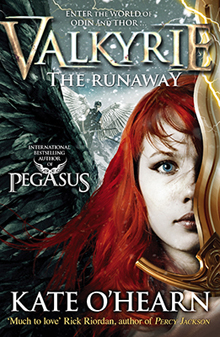 Fifteen-year-old Freya, a Valkyrie, and Archie, her dead human friend, are in trouble with Odin, leader of the highest realm. As a punishment, Freya can only compete in the Three-Strike Sword Challenge against the Dark Searchers and the tug-of-war against the Angels of Death during the Nine Realms Challenge. When Odin sends Freya and Archie on a mission to the World of Man to rescue Brünnhilde, her grandmother, whom he banished to Earth years before, Freya discovers secrets about her genealogy that change everything she thinks she knows about herself. With her deadline from Odin running out, she fights enemies to reunite her family, but can she avert the war that is brewing? O’Hearn includes a “Guide to this World,” which includes information about names and places in Norse mythology. Readers will be primed for the next book in the series.
Fifteen-year-old Freya, a Valkyrie, and Archie, her dead human friend, are in trouble with Odin, leader of the highest realm. As a punishment, Freya can only compete in the Three-Strike Sword Challenge against the Dark Searchers and the tug-of-war against the Angels of Death during the Nine Realms Challenge. When Odin sends Freya and Archie on a mission to the World of Man to rescue Brünnhilde, her grandmother, whom he banished to Earth years before, Freya discovers secrets about her genealogy that change everything she thinks she knows about herself. With her deadline from Odin running out, she fights enemies to reunite her family, but can she avert the war that is brewing? O’Hearn includes a “Guide to this World,” which includes information about names and places in Norse mythology. Readers will be primed for the next book in the series.
—NB
The Silver Gate. Kristin Bailey. 2017. Katherine Tegen/HarperCollins.
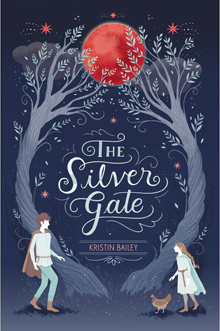 Wynn, an eleven-year-old girl with physical, verbal, and mental disabilities, has been hidden by her mother in the forest since birth because she was considered by the serfs of the village to be a changeling left by the fairies. When Wynn’s mother dies, her father sells her to the lord as a kitchen slave in the castle. Wynn’s brother, Elric, becomes her protector, and they set out on a dangerous journey on which they must deal with treacherous terrain, harsh weather, and superstitious and cruel people. Wynn believes they must follow the clues in the song their mother sang to find and open the Silver Gate to the Fairy Queens’s kingdom, where they can live in safety. Survival will depend on mutual trust and cooperation—and magic.
Wynn, an eleven-year-old girl with physical, verbal, and mental disabilities, has been hidden by her mother in the forest since birth because she was considered by the serfs of the village to be a changeling left by the fairies. When Wynn’s mother dies, her father sells her to the lord as a kitchen slave in the castle. Wynn’s brother, Elric, becomes her protector, and they set out on a dangerous journey on which they must deal with treacherous terrain, harsh weather, and superstitious and cruel people. Wynn believes they must follow the clues in the song their mother sang to find and open the Silver Gate to the Fairy Queens’s kingdom, where they can live in safety. Survival will depend on mutual trust and cooperation—and magic.
—CA
Ages 12–14
The Cursed Queen (The Imposter Queen #2). Sarah Fine. 2017. Margaret K. McElderry/Simon & Schuster.
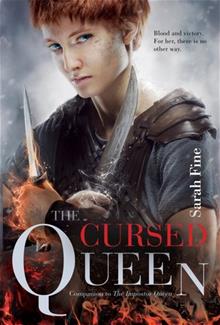 Kidnapped from the Kupari as a youngster and sold into the Krigere tribe, Ansa, now sixteen, has fought hard for respect. In a sea battle against the Kupari, their witch queen curses Ansa with the forbidden magic of fire and ice. If her Krigere companions find out about these dark powers, she will be an exiled from the community of warriors she calls her own. In this companion to The Imposter Queen (2016), the question remains: Who is the real queen of Kupari? Could it be Ansa, even if her allegiance is to their greatest enemy, the Krigere? Will the magic that inhabits her destroy Ansa and those around her before she learns the truth? The dramatic ending sets readers up for the next book in the series in which Ansa might finally discover, and choose, her destiny.
Kidnapped from the Kupari as a youngster and sold into the Krigere tribe, Ansa, now sixteen, has fought hard for respect. In a sea battle against the Kupari, their witch queen curses Ansa with the forbidden magic of fire and ice. If her Krigere companions find out about these dark powers, she will be an exiled from the community of warriors she calls her own. In this companion to The Imposter Queen (2016), the question remains: Who is the real queen of Kupari? Could it be Ansa, even if her allegiance is to their greatest enemy, the Krigere? Will the magic that inhabits her destroy Ansa and those around her before she learns the truth? The dramatic ending sets readers up for the next book in the series in which Ansa might finally discover, and choose, her destiny.
—NB
Siren Sisters. Dana Langer. 2017. Aladdin/Simon & Schuster.
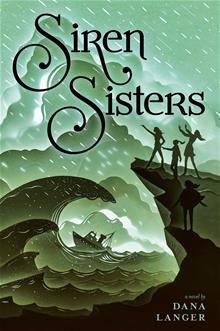 Twelve-year-old Lolly has three beautiful sisters who are regular teens by day and sirens by night, luring sea-going vessels to destruction with their hypnotic songs, and who are upholding a secret deal they made with the Sea Witch. With her thirteenth birthday just around the corner, Lolly knows she doesn’t want to transform into a siren and end up like her sisters, responsible for shipwrecks and unable to live a normal life. After her sisters are captured and put into a deep sleep, Lolly and her best friend, Jason, set out to rescue them, but she soon realizes that real deliverance needs to come from the Sea Witch herself.
Twelve-year-old Lolly has three beautiful sisters who are regular teens by day and sirens by night, luring sea-going vessels to destruction with their hypnotic songs, and who are upholding a secret deal they made with the Sea Witch. With her thirteenth birthday just around the corner, Lolly knows she doesn’t want to transform into a siren and end up like her sisters, responsible for shipwrecks and unable to live a normal life. After her sisters are captured and put into a deep sleep, Lolly and her best friend, Jason, set out to rescue them, but she soon realizes that real deliverance needs to come from the Sea Witch herself.
—NB
Ages 15+
Eat the Sky, Drink the Ocean: Stories of Imagination and Daring. Kirsty Murray, Payal Dhar & Anita Roy (Eds.). 2017. Margaret K. McElderry/Simon & Schuster.
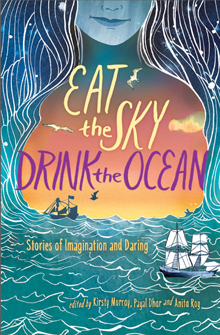 The introduction for this anthology of speculative fiction explains that the title Eat the Sky, Drink the Ocean was chosen to suggest “impossibilities, dreams, ambitions, and a connection to something larger than humanity alone.” The thought-provoking feminist fantasies (ten short stories, six comics, and one play) were created through pairs of contributors from India and Australia. Each piece explores the challenges faced by girls and women in today’s world by imagining other worlds in which impossibilities become possibilities and dreams become realities. The appended “Notes on the Collaborations” section about sharing of ideas as part of the creative process and making connections across the world add interest. Brief notes about the contributors are included.
The introduction for this anthology of speculative fiction explains that the title Eat the Sky, Drink the Ocean was chosen to suggest “impossibilities, dreams, ambitions, and a connection to something larger than humanity alone.” The thought-provoking feminist fantasies (ten short stories, six comics, and one play) were created through pairs of contributors from India and Australia. Each piece explores the challenges faced by girls and women in today’s world by imagining other worlds in which impossibilities become possibilities and dreams become realities. The appended “Notes on the Collaborations” section about sharing of ideas as part of the creative process and making connections across the world add interest. Brief notes about the contributors are included.
—CA
Flicker and Mist. Mary G. Thompson. 2017. Clarion/Houghton Mifflin Harcourt.
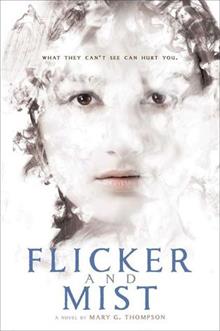 Mixed-race Myra lives with her Leftie mother from whom she inherited the forbidden Ability of Flickering (going invisible) as well as her looks, and her Plat father, a law-abiding Councilman. After Myra accidentally flickered at age five, her father secretly taught her how to control it. Now sixteen, right before the Games in which she anticipates being named best rider with her beast Hoof, nasty pranks allegedly by illegal “flickerkins” turn violent and engage public panic. In a government crackdown, Myra’s parents are jailed for violating the Declaration of Peace and Myra, her Ability undetected, is placed under house arrest. Forced to withdraw from the Games and amidst the political chaos, Myra discovers allies in unexpected places as she searches for meaning in her life and must make an important decision: Choose the Lefties or the Plats.
Mixed-race Myra lives with her Leftie mother from whom she inherited the forbidden Ability of Flickering (going invisible) as well as her looks, and her Plat father, a law-abiding Councilman. After Myra accidentally flickered at age five, her father secretly taught her how to control it. Now sixteen, right before the Games in which she anticipates being named best rider with her beast Hoof, nasty pranks allegedly by illegal “flickerkins” turn violent and engage public panic. In a government crackdown, Myra’s parents are jailed for violating the Declaration of Peace and Myra, her Ability undetected, is placed under house arrest. Forced to withdraw from the Games and amidst the political chaos, Myra discovers allies in unexpected places as she searches for meaning in her life and must make an important decision: Choose the Lefties or the Plats.
—NB
Nancy Brashear is Professor Emeritus of English from Azusa Pacific University, in Azusa, California. Carolyn Angus is former Director of the George G. Stone Center for Children's Books, Claremont Graduate University, in Claremont, California.
These reviews are submitted by members of the International Literacy Association's Children's Literature and Reading Special Interest Group (CL/R SIG) and are published weekly on Literacy Daily
.